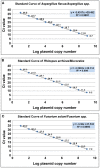Development of a Sensitive and Specific Novel qPCR Assay for Simultaneous Detection and Differentiation of Mucormycosis and Aspergillosis by Melting Curve Analysis
- PMID: 37744098
- PMCID: PMC10512281
- DOI: 10.3389/ffunb.2021.800898
Development of a Sensitive and Specific Novel qPCR Assay for Simultaneous Detection and Differentiation of Mucormycosis and Aspergillosis by Melting Curve Analysis
Abstract
Molecular diagnostic assays can expedite the diagnosis of fungal infections, and subsequently help in early interventions and appropriate management of patients. The aim of this study was to develop a single set of primers for a real-time quantitative polymerase chain reaction (qPCR) assay to detect and identify commonly reported, clinically relevant molds i.e., Aspergillus spp, Mucorales and Fusarium spp., up to genus level by melting curve analysis. This assay was evaluated in whole blood from patients with suspected invasive aspergillosis (IA), and in tissue biopsy, bronchoalveolar lavage (BAL) fluid and other site-specific samples from patients with suspected invasive mucormycosis (IM). The limit of detection (LoD) was determined as 10 copies/μl for all three molds. The mean coefficient of variation (CV) across all sets of intra- and inter-assay data was 0.63% (ranging from 0.42 to 1.56%), showing high reproducibility of the assay. Sensitivity and specificity of the assay were 93.3 and 97.1% respectively for diagnosis of IA, and 99.29 and 83.84% respectively for diagnosis of IM. Fusarium was not detected in any of the clinical samples included and the few laboratory confirmed cases of fusariosis did not meet the inclusion criteria of the study. Hence no ROC curve or cutoff value could be generated for the same. This newly developed qPCR assay therefore appears to be a promising tool in detection of IA and IM.
Keywords: invasive aspergillosis; invasive fusariosis; invasive mucormycosis; melting curve analysis; real-time PCR.
Copyright © 2022 Pandey, Xess, Sachdev, Yadav, Singh, Pradhan, Xess, Rana, Dar, Bakhshi, Seth, Mahapatra, Jyotsna, Jain, Kumar, Agarwal and Mani.
Conflict of interest statement
The authors declare that the research was conducted in the absence of any commercial or financial relationships that could be construed as a potential conflict of interest.
Figures





Similar articles
-
Utility of in-house and commercial PCR assay in diagnosis of Covid-19 associated mucormycoss in an emergency setting in a tertiary care center.J Med Microbiol. 2023 Aug;72(8). doi: 10.1099/jmm.0.001745. J Med Microbiol. 2023. PMID: 37624041
-
Quantitative PCR (qPCR) Detection of Mucorales DNA in Bronchoalveolar Lavage Fluid To Diagnose Pulmonary Mucormycosis.J Clin Microbiol. 2018 Jul 26;56(8):e00289-18. doi: 10.1128/JCM.00289-18. Print 2018 Aug. J Clin Microbiol. 2018. PMID: 29875192 Free PMC article.
-
Discrimination of Aspergillosis, Mucormycosis, Fusariosis, and Scedosporiosis in Formalin-Fixed Paraffin-Embedded Tissue Specimens by Use of Multiple Real-Time Quantitative PCR Assays.J Clin Microbiol. 2016 Nov;54(11):2798-2803. doi: 10.1128/JCM.01185-16. Epub 2016 Sep 7. J Clin Microbiol. 2016. PMID: 27605714 Free PMC article.
-
PCR diagnostic platforms for non-Aspergillus mold infections: ready for routine implementation in the clinic?Expert Rev Mol Diagn. 2024 Apr;24(4):273-282. doi: 10.1080/14737159.2024.2326474. Epub 2024 Mar 19. Expert Rev Mol Diagn. 2024. PMID: 38501431 Review.
-
Diagnosis of Fungal Infections. A Systematic Review and Meta-Analysis Supporting American Thoracic Society Practice Guideline.Ann Am Thorac Soc. 2019 Sep;16(9):1179-1188. doi: 10.1513/AnnalsATS.201811-766OC. Ann Am Thorac Soc. 2019. PMID: 31219341
Cited by
-
Rise of mucormycosis during the COVID-19 pandemic and the challenges faced.Curr Med Mycol. 2023 Mar;9(1):44-55. doi: 10.18502/cmm.2023.345032.1400. Curr Med Mycol. 2023. PMID: 37867589 Free PMC article. Review.
-
Mucormycosis diagnosis revisited: Current and emerging diagnostic methodologies for the invasive fungal infection (Review).Exp Ther Med. 2022 Dec 5;25(1):47. doi: 10.3892/etm.2022.11746. eCollection 2023 Jan. Exp Ther Med. 2022. PMID: 36569440 Free PMC article. Review.
-
The diagnosis of mucormycosis by PCR in patients at risk: a systematic review and meta-analysis.EClinicalMedicine. 2025 Feb 22;81:103115. doi: 10.1016/j.eclinm.2025.103115. eCollection 2025 Mar. EClinicalMedicine. 2025. PMID: 40083443 Free PMC article.
-
Molecular Assays Versus Mycological Methods for Diagnosis of Rhino Orbital Mucormycosis: Analysis of 120 Clinical Specimens from COVID-19 Patients.Mycopathologia. 2025 Mar 5;190(2):30. doi: 10.1007/s11046-025-00937-7. Mycopathologia. 2025. PMID: 40045088
-
Digital PCR assays for quantifying trichothecene-producing Fusarium species, including Fusarium langsethiae, F. poae, and F. sporotrichioides, in oats.Anal Bioanal Chem. 2025 May;417(13):2957-2969. doi: 10.1007/s00216-025-05840-0. Epub 2025 Mar 21. Anal Bioanal Chem. 2025. PMID: 40116867 Free PMC article.
References
-
- Alonso M., Escribano P., Guinea J., Recio S., Simon A., Peláez T., et al. . (2012). Rapid detection and identification of aspergillus from lower respiratory tract specimens by use of a combined probe–high-resolution melting analysis. J. Clinic. Microbiol. 50, 3238–3243. 10.1128/JCM.00176-12 - DOI - PMC - PubMed
-
- Bergeron A., Porcher R., Menotti J., Poirot J. L., Chagnon K., Vekhoff A., et al. . (2012). Prospective evaluation of clinical and biological markers to predict the outcome of invasive pulmonary aspergillosis in hematological patients. J. Clinic. Microbiol. 50, 823–830. 10.1128/JCM.00750-11 - DOI - PMC - PubMed
LinkOut - more resources
Full Text Sources
Miscellaneous

